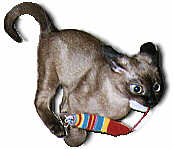
The Orange Gene:
Sex-Linked Genetics over Dessert
by Jo L. Whitman
Alethea Cattery
P.O. Box 2343
Woodinville, WA 99072-2343 USA
E-Mail:
In memory of my dad, D.W. Whitman, 2/18/14 to 10/13/96,
from whom I really did learn most of this stuff at the dinner table.
(Of interest to Burmese breeders, this discussion assumes familiarity with the material in the Dinner Table Analysis of Color Genetics, also written by Jo Whitman and published with permission by Darbie Marlin.)
The gender of a kitten is determined by a pair of chromosomes called the X-Y chromosomes. Males have one X and one Y (XY), and females have two Xs (XX). A gene is called sex-linked if it appears on the portion of the X chromosome which is absent from the Y chromosome.
Well known examples in humans are color-blindness and male-patterned-baldness. In felines, the best known example is the Orange gene.
Using the notation "O" for an "X" chromosome with an orange gene, and "X","Y" for chromosomes without the orange gene, the possible combinations are:
| XX | XY |
| XO | |
| OO | OY |
where the left column are females, the right column are males, the first row exhibits the base coat color, the third row masks the base color, and the second row shows a partial mask or tortoiseshell coat.
The best known example is a tortoiseshell-and-white (calico in the United States) cat. Using a black solid-coat cat as a reference, here are some examples:
- BBDDcc XX ss : black solid coat female, no white spotting factor
- BBDDcc XY S_ : black-and-white bicolor male (with W spotting factor)
- BBDDcc OY ss : red male masking black
- BBDDcc OO S_ : red-and-white bicolor female masking black
- BBDDcc XO ss : tortoiseshell female (black and red)
- BBDDcc XO S_ : calico female (red-and-black and white)
The blanks next to the 'S' could be either 'S' or 's' due to the White Spotting Gene ('S') being dominant.
Returning to Burmese, cream is the dilute form of red, just like lilac is the dilute form of champagne & blue is the dilute form of sable.
Note that the calicos and torties (slang for tortoiseshells) are female because of the two "X" chromosomes, one with & one without the Orange gene. Occasionally a male calico or tortie is heard of: these are genetically X-O-Y, a genetic "typo", and therefore sterile. They are rare.
Inheritance of the X-Y-O genes is governed by Chart 14. Use it carefully. A non-red male (XY) could only produce offspring in the left two columns. A red/cream male (YO) could only produce offspring in the right two columns. A non-red female (XX) could only produce offspring in the top row. A red (OO) female could only produce offspring in the last row. A tortoiseshell (XO) female could produce offspring in both rows.
| Chart 14 | sire gives offspring: | |||
| X | Y | O | ||
| dam gives offspring: |
X | XX | XY | O |
| O | XO | YO | OO | |
Each of these five possible combinations could occur with each of the classical four Burmese coat colors. Chart 15 shows what color cat these genetic combinations will produce.
| Chart 15 | XX | XY | XO | OY | OO | |
| B_D_ | sable | sable |
sable tortie |
red mask sable |
red mask sable |
|
| bbD_ | chocolate | chocolate |
chocolate tortie |
red mask chocolate |
red mask chocolate |
|
| B_dd | blue | blue |
blue tortie |
cream mask blue |
cream mask blue |
|
| bbdd | lilac | lilac |
lilac tortie |
cream mask lilac |
cream mask lilac |
|
| (Left column is Burmese coat-color. Top is X-Y chromosomes.) | ||||||
Note that this is a phenotype-from-genotype look-up chart, rather than either of the types presented previously. Refer to Charts 5 & 7 for the usual mating charts, and to Charts 9, 13 & 14 for calculating possibilities inherited. Charts 13 & 14 provide the probability percentages for the phenotypes shown in Chart 15. For complete 10-color mating chart, see the
Read more about it:
Basic Genetics: Coat Colours with Red
Burmese Mating Color Charts
|
Moonmaid Home Page |
Moonmaid Color Gallery |
Moonmaid Cat Links |
Burmese Color Charts |
|
Dinner Table Analysis of Color Genetics |
The Orange Gene: Sex-Linked Genetics over Dessert |
||